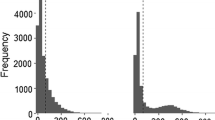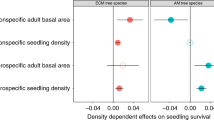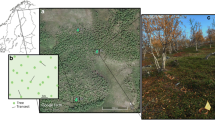Abstract
Mycorrhizal fungi symbioses can be critical determining if established seedlings survive or not. Currently, in remnant forests, plants and their fungal symbionts are exposed to varied anthropomorphic effects related to urbanization, however, little is known about their impact on this association. We investigated the relationship between mycorrhizal fungi and tree seedling survival along an urbanization gradient. We planted three species of temperate tree seedlings (Acer rubrum, Carya ovata, and Quercus rubra) in three landscapes: urban, suburban, and rural. We measured the percent of root length colonized by mycorrhizal fungi and monitored survival during their first growing season. We analyzed mycorrhizal colonization as a function of landscape type (urban-rural) and additional variables known to contribute to mycorrhizal colonization (phosphorus, nitrogen, initial plant height). We then analyzed seedling survival as a function of the degree of mycorrhizal fungi colonization associated with the landscape gradient and of additional environmental factors (light and soil moisture). Within a species we found no changes in the levels of mycorrhizal fungi colonization across the urbanization gradient. Each species, however, had markedly different levels of colonization. Survival of A. rubrum was independent of mycorrhizal colonization, while C. ovata and Q. rubra had a significant positive response to increased mycorrhizal fungi. These findings highlight the resilience of mycorrhizal communities across the rural-urban gradient typical of this region, but they also underscore the potential sensitivity of some tree species to lower levels of mycorrhizal fungi colonization.





Similar content being viewed by others
References
Abrams MD, Ruffner CM (1995) Physiographic analysis of witness-tree distribution (1765-1798) and present Forest cover through north Central Pennsylvania. Can J For Res 25(4):659–668
Bainard LD, Klironomos JN, Gordon AM (2011) The mycorrhizal status and colonization of 26 tree species growing in urban and rural environments. Mycorrhiza 21(2):91–96
Barnes GV, Wagner WH (2004) Michigan trees. The University of Michigan Press, Ann Arbor, Michigan
Bingham MA, Simard S (2012) Ectomycorrhizal networks of Pseudotsuga menziesii var glauca trees facilitate establishment of conspecific seedlings under drought. Ecosystems 15(2):188–199
Brundrett MC (2009) Mycorrhizal associations and other means of nutrition of vascular plants: understanding the global diversity of host plants by resolving conflicting information and developing reliable means of diagnosis. Plant Soil 320(1–2):37–77
Burns RM, Honkala BH (1990) Silvics of North America. Agriculture handbook 654. US Department of Agriculture, Forest Service, Washington, DC 877 p
Canham CD, Kobe RK, Latty EF, Chazdon RL (1999) Interspecific and intraspecific variation in tree seedlings survival: effects of allocation to roots versus carbohydrates reserves. Oecologia 121:1–11
City of Ann Arbor (2014) City of Ann Arbor Urban and Community Forest Management Plan. Ann Arbor, MI
Comas LH, Eissenstat DM (2009) Patterns in root trait variation among 25 co-existing north American forest species. New Phytol 182(4):919–928
Cousins JR, Hope D, Gries C, Stutz JC (2003) Preliminary assessment of arbuscular mycorrhizal fungal diversity and community structure in an urban ecosystem. Mycorrhiza 13(6):319–326
Dickie IA, Koide RT, Steiner KC (2002) Influences of established trees on mycorrhizas, nutrition, and growth of Quercus rubra. Ecol Monogr 72(4):505–521
Duchicela J, Sullivan TS, Bontti E, Bever JD (2013) Soil aggregate stability increase is strongly related to fungal community succession along an abandoned agricultural field chronosequence in the Bolivian Altiplano. J Appl Ecol 50:1266–1273
Egerton-Warburton LM, Allen EB (2000) Shifts in arbuscular mycorrhizal communities along an anthropogenic nitrogen deposition gradient. Ecol Appl 10(2):484–496
File AL, Klironomos J, Maherali H, Dudley SA (2012) Plant kin recognition enhances abundance of symbiotic microbial partner. PLoS One 7(9):15–17
Fitter AH, Heinemeyer A, Husband R, Olsen E, Ridgway KP, Staddon PL (2004) Global environmental change and the biology of arbuscular mycorrhizas: gaps and challenges. Can J Bot 82:1133–1139
Gómez-Aparicio L, Perez-Ramos IM, Mendoza L, Quero JL, Castro J, Zamora R, Maranon T (2008) Oak seedling survival and growth along resource gradients in Mediterranean forests: implications for regeneration in current and future environmental scenarios. Oikos 117:1683–1699
Guerrero CC, Günthardt-Goerg MS, Vollenweider P (2013) Foliar symptoms triggered by ozone stress in irrigated holm oaks from the city of Madrid, Spain. PLoS One 8(7):e69171
Hartman JP, Buckley DS, Sharik TL (2005) Differential success of oak and red maple regeneration in oak and pine stands on intermediate-quality sites in northern lower Michigan. For Ecol Manag 216(1–3):77–90
Hartnett DC, Wilson GWT (1999) Mycorrhizae influence plant community structure and diversity in Tallgrass prairie. Ecology 80(4):1187–1195
Horton TR, Bruns TD, Parker VT (1999) Ectomycorrhizal fungi associated with Arctostaphylos contribute to Pseudotsuga menziesii establishment. Can J Bot 77(1):93–102
Hosseini Bai S, Xu Z, Blumfield TJ, Reverchon F (2015) Human footprints in urban forests: implication of nitrogen deposition for nitrogen and carbon storage. J Soils Sediments 15(9):1927–1936
Ibáñez I, McCarthy-Neumann S (2014) Integrated assessment of the direct and indirect effects of resource gradients on tree species recruitment. Ecology 95:364–375
Ibáñez I, McCarthy-Neumann S (2016) Effects of mycorrhizal fungi on tree seedling growth: quantifying the parasitism–mutualism transition along a light gradient. Can J For Res 46:48–57
Jin L, Wang S, Wang X, Shen Y (2009) Seed size influences arbuscular mycorrhizal symbiosis across leguminous host-plant species at the seedling stage. Symbiosis 49(3):111–116
Johnson NC, Wilson GWT, Wilson JA, Miller RM, Bowker MA (2015) Mycorrhizal phenotypes and the law of the minimum. New Phytol 205(4):1473–1484
Karliński L, Jagodziński AM, Leski T, Butkiewicz P, Brosz M, Rudawska M (2014) Fine root parameters and mycorrhizal colonization of horse chestnut trees (Aesculus hippocastanum L) in urban and rural environments. Landsc Urban Plan 127:154–163
Karpati AS, Handel SN, Dighton J, Horton TR (2011) Quercus rubra-associated ectomycorrhizal fungal communities of disturbed urban sites and mature forests. Mycorrhiza 21(6):537–547
Katz DSW, Lovett GM, Canham CD, Reilly CMO (2010) Legacies of land use history diminish over 22 years in a forest in southeastern New York author. Torrey Botanical Society 137(2/3):236–251
Kielbaso J (1990) Trends and issues in City forests. J Arboric 16(3):69–76
Lewis JD, Licitra J, Tuininga AR, Sirulnik A, Turner GD, Johnson J (2008) Oak seedling growth and ectomycorrhizal colonization are less in eastern hemlock stands infested with hemlock woolly adelgid than in adjacent oak stands. Tree Physiol 28(4):629–636
Martin LJ, Blossey B, Ellis E (2012) Mapping where ecologists work: biases in the global distribution of terrestrial ecological observations. Front Ecol Environ 10(4):195–201
Martínez-García LB, Ochoa-Hueso RL, Manrique E, Pugnaire FI (2015) Different mycorrhizal fungal strains determine plant community response to nitrogen and water availability. J Plant Nutr Soil Sci 178:146–154. doi:10.1002/jpln.201300548
McGonigle ATP, Miller MH, Evans DG, Fairchild GL, Swan JA (1990) A new method which gives an objective measure of colonization of roots by vesicular- arbuscular mycorrhizal fungi. New Phytol 115(3):495–501
Menkis A, Vasiliauskas R, Taylor AFS, Stenlid J, Finlay R (2007) Afforestation of abandoned farmland with conifer seedlings inoculated with three ectomycorrhizal fungi - impact on plant performance and ectomycorrhizal community. Mycorrhiza 17(4):337–348
Miao S (1995) Acorn mass and seedling growth in Quercus rubra in response to elevated CO2. J Veg Sci 6(5):697–700
Millar JA, Ballhorn DJ (2013) Effect of mycorrhizal colonization and light limitation on growth and reproduction of lima bean (Phaseolus lunatus L). J Appl Bot Food Qual 86:172–179
Mordecai EA (2012) Soil moisture and fungi affect seed survival in California grassland annual plants. PLoS One 7(6):e039083
Nara K, Hogetsu T (2004) Ectomycorrhizal fungi on established shrubs facilitate subsequent seedling establishment of successional plant species source. Ecology 85(6):1700–1707
O’Brien MJ, Gomola CE, Horton TR (2011) The effect of forest soil and community composition on ectomycorrhizal colonization and seedling growth. Plant Soil 341:321–331
O’Brien AM, Ettinger AK, HilleRisLambers J (2012) Conifer growth and reproduction in urban forest fragments: predictors of future responses to global change? Urban Ecosyst 15(4):879–891
Oke TR (1973) City size and the urban Heat Island. Atmos Environ 7:769–777
Parker WC, Pitt G, Morneault AE (2009) Influence of woody and herbaceous competition on microclimate and growth of eastern white pine (Pinus strobus L) seedlings planted in a Central Ontario clearcut. For Ecol Manag 258(9):2013–2025
Phillips RP, Fahey TJ (2006) Tree species and mycorrhizal associations influence the magnitude of Rhizosphere effects. Ecology 87(5):1302–1313
Propster JR, Johnson NC (2015) Uncoupling the effects of phosphorus and precipitation on arbuscular mycorrhizas in the Serengeti. Plant Soil 388(1–2):21–34
R Core Team (2015) R: A language and environment for statistical computing R Foundation for Statistical Computing, Vienna, Austria URL http://www.R-projectorg/
Reinmann AB, Templer PH (2016) Reduced winter snowpack and greater soil frost reduce live root biomass and stimulate radial growth and stem respiration of red maple (Acer rubrum) trees in a mixed-hardwood. Forest Ecosyst 19(1):129–141
Rillig MC, Wright SF, Shaw MR, Field CB, Artificial CB (2002) Artificial climate warming positively affects arbuscular mycorrhizae but decreases soil aggregate water stability in an annual grassland. Oikos 97(1):52–58
Rodríguez-Calcerrada J, Cano FJ, Valbuena-Carabaña M, Gil L, Aranda I (2010) Functional performance of oak seedlings naturally regenerated across microhabitats of distinct overstory canopy closure. New For 39(2):245–259
Roger A, Colard A, Angelard C, Sanders IR (2013) Relatedness among arbuscular mycorrhizal fungi drives plant growth and intraspecific fungal coexistence. ISME J 7(11):2137–2146
Ruddiman WF (2013) The Anthropocene. Annu Rev Earth Planet Sci 41(1):45–68
Setala H, Viippola V, Rantalainen AL, Pennanen A, Yli-Pelkonen V (2013) Does urban vegetation mitigate air pollution in northern conditions? Environ Pollut 183:104–112
Skogley E (1992) The universal Bioavaliability enviroment/soil test Unibest. Commun Soil Sci Plant Anal 23(17–20):2225–2246
Spiegelhalter DJ, Best NG, Carlin BP, van der Linde A (2002) Bayesian measures of model complexity and fit (with discussion). J R Stat Soc 64:583–639
Sun FF, Wen DZ, Kuang YW, Li J, Zhang JG (2009) Concentrations of Sulphur and heavy metals in needles and rooting soils of Masson pine (Pinus massoniana L) trees growing along an urban-rural gradient in Guangzhou, China. Environ Monit Assess 154(1–4):263–274
Teste FP, Simard SW (2008) Mycorrizal networks and distance from mature trees Alter patterns of competition and facilitation in dry Douglas-fir forests. Oecologia 158(2):193–203
Thomas A, O'Hara R, Ligges U, Sturts S (2006) Making BUGS Open. R News 6:12–17
Thomas-Van Gundy M, Rentch J, Adams MB, Carson W (2014) Reversing legacy effects in the understory of an oak-dominated forest. Can J For Res 44(4):350–364
Tinker PB, Gildon A (1983) Interactions of vesicular-arbuscular mycorrhizal infection and heavy metals in plants. New Phytol 95(2):247–261
Treseder K (2004) Meta-Alalysis of mycorrhizal responses to nitrogen, phosphorus, and atmospheric CO2 in field studies. New Phytol 164(2):347–355
Treseder KK (2013) The extent of mycorrhizal colonization of roots and its influence on plant growth and phosphorus content. Plant Soil 371(1–2):1–13
Treseder KK, Allen MF (2000) Mycorrhizal fungi have a potential role in soil carbon storage under elevated CO2 and nitrogen deposition. New Phytol 147(1):189–200
US Census (2010) QuickFacts, Ann Arbor city, Michigan United States Census Bureau http://wwwcensusgov/quickfacts/table/RHI105210/2603000,26161
US Census (2014) Annual Estimates of the Resident Population for Incorporated Places of 50,000 or More, Ranked by July 1, 2014 Population: April 1, 2010 to July 1, 2014 - United States -- Places of 50,000+ Population 2014 Population Estimates United States Census Bureau http://factfindercensus.gov/faces/tableservices/jsf/pages/productviewxhtml?src=bkmk
Vailshery LS, Jaganmohan M, Nagendra H (2013) Effect of street trees on microclimate and air pollution in a tropical city. Urban For Urban Green 12(3):408–415
Van Der Heijden MGA, Horton TR (2009) Socialism in soil? The importance of mycorrhizal fungal networks for facilitation in natural ecosystems. J Ecol 97:1139–1150
Van Der Heijden MGA, Boller T, Wiemken A, Sanders IR (1998) Different arbuscular mycorrhizal fungal species are potential determinants of plant community structure. Ecology 79(6):2082–2091
Woodward C, Johnson DW, Meadows MW, Miller WW, Hynes MM, Robertson CM (2013) Nutrient hot spots in a sierra Nevada Forest soil: temporal characteristics and relations to microbial communities. Soil Sci 178(11):585–595
Xian G, Homer C, Dewitz J, Fry J, Hossain N, Wickham J (2011). The change of impervious surface area between 2001 and 2006 in the conterminous United States. Photogramm Eng Remote Sens 77(8): 758–762
Yang Y, Song Y, Scheller HV, Ghosh A, Ban Y, Chen H, Tan M (2015) Community structure of arbuscular mycorrhizal fungi associated with Robinia pseudoacacia in uncontaminated and heavy metal contaminated soils. Soil Biol Biochem 86:146–158
Youngsteadt E, Dale AG, Terando AJ, Dunn RR, Frank SD (2015) Do cities simulate climate change? A comparison of herbivore response to urban and global warming. Glob Chang Biol 21(1):97–105
Acknowledgements
Funding was provided by the National Science Foundation to I. Ibáñez (award No.: DEB 1252664).
Author information
Authors and Affiliations
Corresponding author
Appendix
Appendix
Model code


Rights and permissions
About this article
Cite this article
Tonn, N., Ibáñez, I. Plant-mycorrhizal fungi associations along an urbanization gradient: implications for tree seedling survival. Urban Ecosyst 20, 823–837 (2017). https://doi.org/10.1007/s11252-016-0630-5
Published:
Issue Date:
DOI: https://doi.org/10.1007/s11252-016-0630-5






